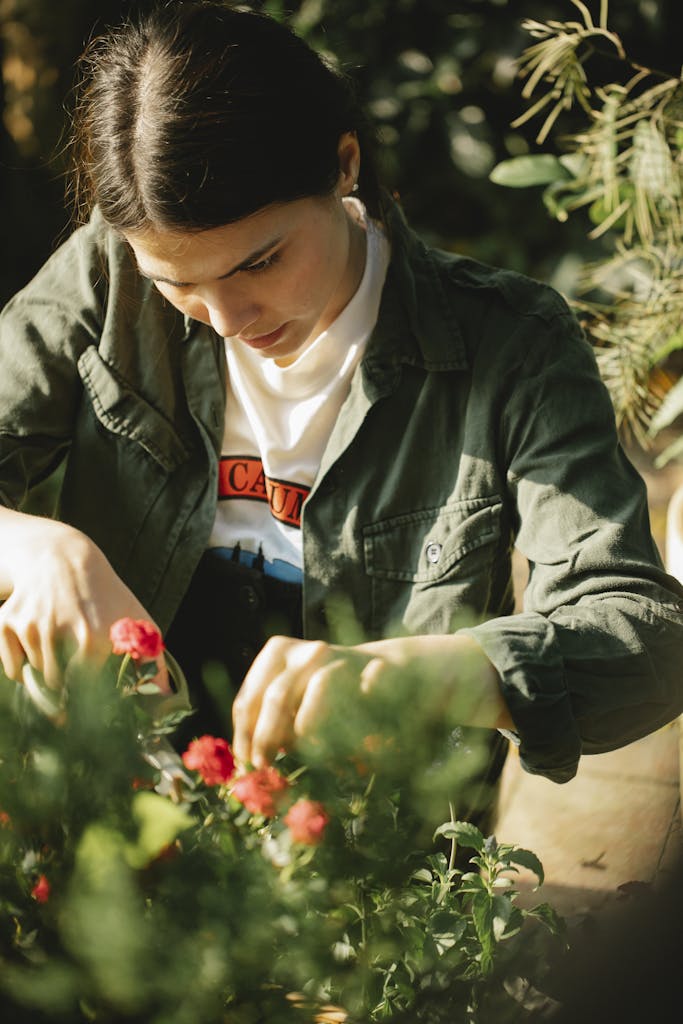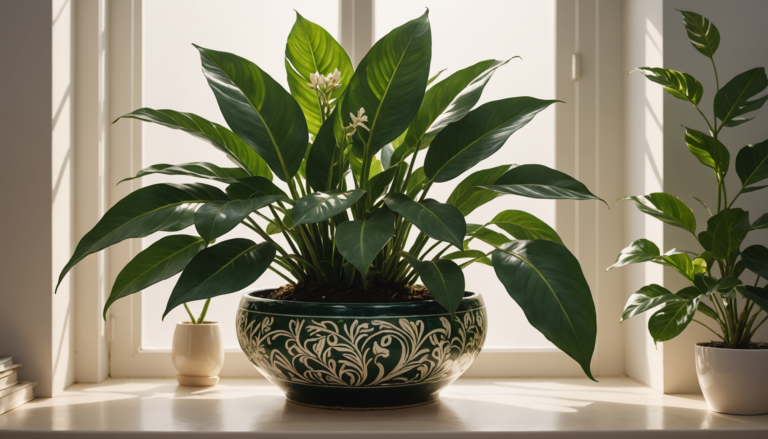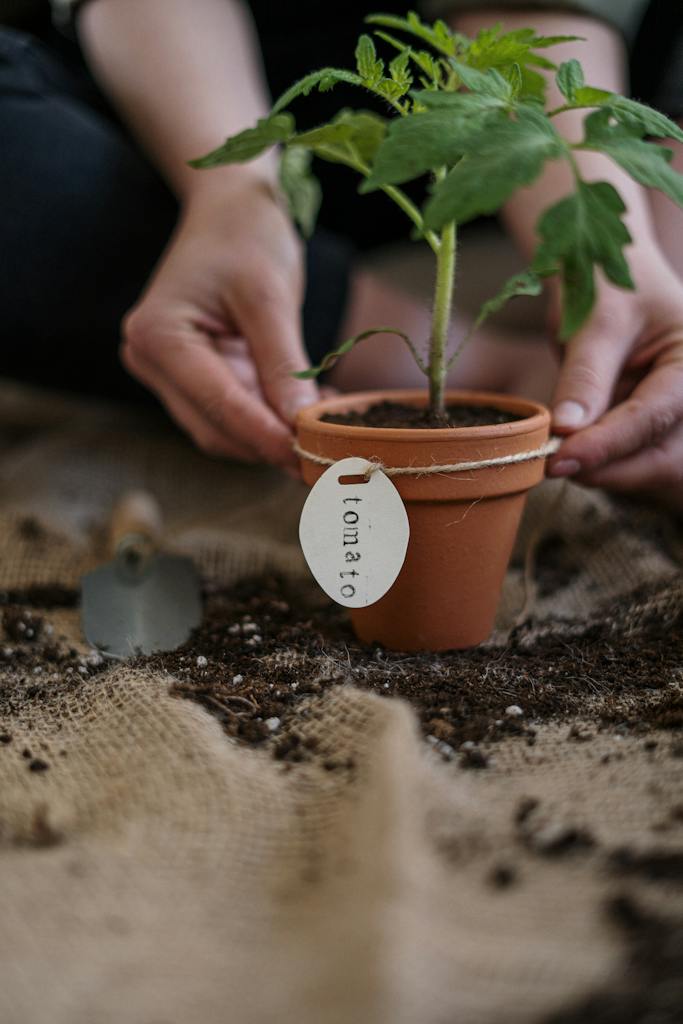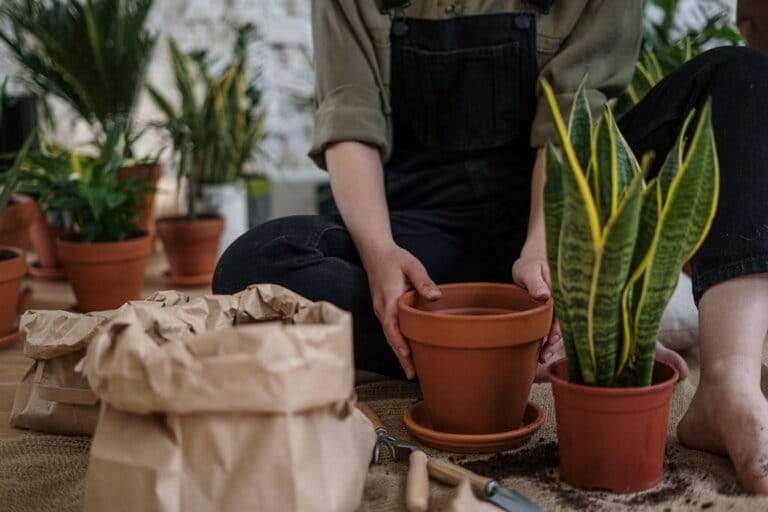The mirror image of flowers has always intrigued me, particularly those that bear a similarity to the blossom of chamomile.
I’ve found the world full of flowers masquerading as our beloved Chamomile: scentless mayweed, stinking Chamomile or Anthemis cotula, and wild Chamomile or Chamomile Matricaria, to name a few.
Let’s dive in, unravel these deceptive beauties, and equip ourselves with the knowledge to discern true Chamomile from its pretenders.
Who’s ready to embark on this botanical adventure with me?
Key Takeaways
- German Chamomile has small, daisy-like flowers with white petals and yellow centers. It is known for its calming and anti-inflammatory benefits.
- Spanish Chamomile has brighter yellow petals than typical Chamomile and can grow taller, reaching over two feet.
- Scentless Mayweed can be distinguished from Chamomile’s lack of scent, smaller hollow receptacles, and broader leaves.
- Stinking Chamomile has a strong, unpleasant odor, smaller, densely packed flowers resembling daisies, and finely divided leaves.
A Closer Look at the Chamomile Flower and Its Unique Features
Let’s take a moment to closely examine the chamomile flower, focusing on its unique features.
We’ll start by understanding the characteristics of a true chamomile plant before moving on to the German and Spanish variants.
Each type has notable attributes that set it apart and make it a special part of the floral world.
Understanding the Characteristics of a True Chamomile Plant
Now, I will delve into the unique features of a true chamomile plant, giving a closer look at its distinct characteristics. It’s crucial to understand the nuances of a true chamomile flower.
Here are some key characteristics of a true chamomile plant:
- The flowers: True Chamomile has daisy-like flowers with white petals and yellow centers.
- The leaves: They’re finely divided and feathery, much like ferns.
- The scent: Crushing the plant releases a sweet, apple-like fragrance, a distinctive trait of true Chamomile.
Recognizing these features will help you differentiate a genuine chamomile plant from its look-alikes. So, take your time, observe closely, and you’ll be able to identify Chamomile with ease.
Overview of German Chamomile and Its Features
Often, I find myself captivated by the German Chamomile, a variant of the chamomile flower, and its unique features.
This overview of German Chamomile and its features will help you discern it from plants that look like Chamomile.
The flowers of this plant are characterized by their small, daisy-like appearance. The white petals are beautifully contrasted by a yellow center, making it a pleasant sight in any garden.
Its foliage is finely divided and feathery, which sets it apart from look-alikes.
But it’s not just about aesthetics. The German Chamomile is also renowned for its medicinal properties. With its calming and anti-inflammatory benefits, it’s more than just a look alike. It’s a garden gem.
Notable Attributes of Spanish Chamomile
I’m turning my attention to the Spanish Chamomile, another intriguing variant of the chamomile flower, to delve into its unique attributes.
The Spanish Chamomile is a chamomile look-alike despite having several distinctive attributes that make it stand out among chamomile doppelgangers.
- First, the Spanish Chamomile has a more robust and slightly spicier aroma compared to its counterparts. Its scent is a notable attribute of Spanish Chamomile, distinguishing it from other plants resembling it.
- Additionally, its petals are more radiant, a brighter yellow compared to the typical pale hue of other chamomile species.
- Lastly, Spanish Chamomile has a more substantial growth habit, often reaching heights of over two feet.
These unique characteristics make the Spanish Chamomile a standout among chamomile doppelgangers.
Scentless Doesn’t Mean Chamomile: Identifying Scentless Mayweed
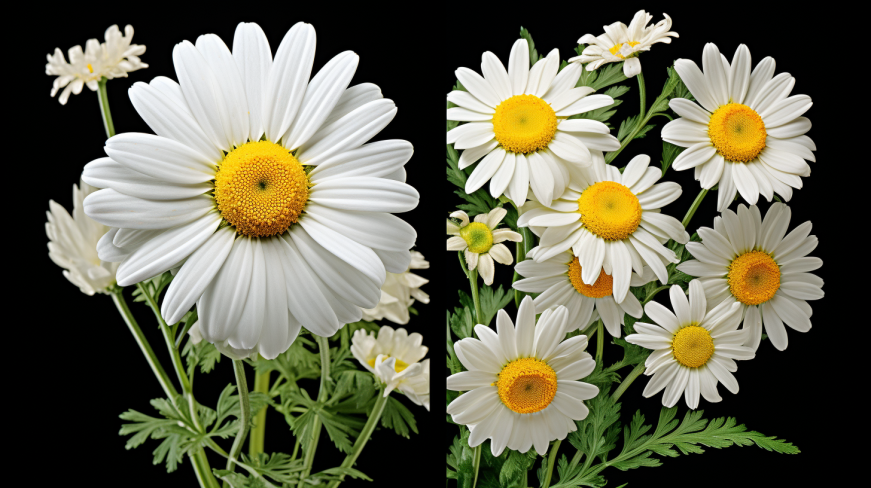
Now, let’s move on to something that often gets mistaken for Chamomile – the scentless mayweed. Just because it doesn’t have a smell doesn’t mean it’s Chamomile.
We’re going to highlight the key differences between these two flowers, identify the unique characteristics of mayweed, and explore its biological role and uses.
Key Differences Between Mayweed and Chamomile Flowers
I’ve identified five key differences between mayweed and chamomile flowers that’ll help you avoid confusion in the future.
Firstly, they have a delightful, apple-like scent, while mayweed, as the name suggests, is odorless.
Secondly, the center is solid and larger, whereas mayweed has a hollow, smaller receptacle.
Lastly, chamomile leaves are finely divided and almost feathery, while mayweed leaves are more broad and divided.
Understanding these key differences is crucial as these two plants can often look alike, confusing. In fact, some plants may be almost identical to German Chamomile, making it essential to know what kind of Chamomile you are dealing with.
Identifying Characteristics of Mayweed
Let’s dive into the specifics of mayweed, and don’t let its lack of aroma fool you into thinking it’s Chamomile. This annual plant has identifying characteristics that help differentiate it from Chamomile, even though they look similar.
Here’s a comparison table of their features:
| Mayweed | Chamomile |
| White and yellow compound flowers | White and yellow daisy-like flowers |
| Blooms May-October | Blooms June-July |
| Grows 10-60 cm tall | Grows 20-30 cm tall |
| Leaves are pinnately divided | Leaves are feathery and delicate |
Understanding the Biological Role and Uses of Mayweed
I’m going to delve into the biological role and numerous uses of the mayweed, a plant often mistaken for Chamomile due to similar appearances. Understanding the biological role of this Chamomile look alike, we find that it’s a valuable part of our ecosystem.
It provides food and habitat for various insects, contributing to biodiversity.
Regarding its uses, the mayweed isn’t just another of the plants that look like Chamomile; it has its own unique applications:
- It’s been used in traditional medicine for treating minor ailments like colds.
- In agriculture, it can serve as a soil improver due to its deep roots.
- The plant is also used in ornamental gardening for its delicate, daisy-like flowers.
The Deceptive Beauty of Stinking Chamomile
I’m about to shed light on the deceptive beauty of Stinking Chamomile.
We’ll explore its distinguishing features and clarify how it differs from true Chamomile.
We’re also going to touch on the importance and uses of this often misidentified plant.
Distinguishing Features of Stinking Chamomile
I’ve always found the deceptive beauty of Anthemis cotula fascinating. It’s easy to mistake it for its more beloved cousin, the true Chamomile. Although these plants look like Chamomile, there are distinguishing features that can help you spot the difference.
Here’s how you can tell them apart:
- It has a strong, unpleasant odor, hence its name. True Chamomile may, on the other hand, have a sweet, apple-like fragrance.
- The flowers of Anthemis cotula are similar to daisies, but they’re smaller and more densely packed on the stem. Unlike Chamomile, its flowers may differ from Chamomile and are smaller.
- Lastly, its leaves are finely divided, giving them a feathery appearance. In contrast, true Chamomile has broader, less divided leaves. Anthemis cotula’s leaves are finer than Chamomile and are similar to fennel.
How Stinking Chamomile Differs from True Chamomile
There’s a handful of key differences that I’ll discuss to help you distinguish between the deceptive beauty of Stinking Chamomile and true Chamomile. When trying to master how it differs from true Chamomile, it’s essential to look closely at their appearances and scents.
| Feature | Stinking Chamomile | True Chamomile |
| Flower Head | Single, with hollow cone | Double, with solid cone |
| Leaves | Very fine, almost thread-like | Bigger, with a more daisy-like shape |
| Scent | Strong, unpleasant, hence the name | Sweet, apple-like |
Importance and Uses of Stinking Chamomile
Despite its off-putting name and odor, I’ll delve into the importance and uses of Stinking Chamomile. This will focus on its role in the ecosystem and traditional medicine and how it’s not just a pesky weed but a plant with potential benefits.
Anthemis cotula, often mistaken for Matricaria or scentless Chamomile due to its chamomile look, is a vital part of the ecosystem. It provides food for various insects and helps maintain biodiversity.
Medicinally, it has been used in traditional remedies despite its unpleasant smell. Some of the uses include treating digestive issues, soothing skin conditions, and promoting relaxation.
Its ability to thrive in poor soil conditions also makes it an excellent plant for soil stabilization and erosion control. It is also commonly used to make chamomile tea and chamomile oil can be extracted from it for various purposes.
It has bright white flowers with yellow centers, similar to daisies. These white flowers of this plant, often confused with Chamomile, are fine and similar to fennel. Unlike actual Chamomile, it is an annual plant.
In contrast, German Chamomile grows larger and flatter than Chamomile and has yellow petals. It is one of the plants that look similar to Chamomile but has distinctive differences.
There’s also English Chamomile, which is another variety of Chamomile found in countries like England. It is a perennial and is commonly used to make chamomile tea.
So, while Stinking Chamomile may be confused with Chamomile, there are various types, including German Chamomile, English Chamomile, and scentless Chamomile, each with its unique characteristics and uses in the ecosystem and traditional medicine. The 25 bright white flowers that bloom on Anthemis cotula may not have the scent and taste of pineapple. Still, they do play a significant role in nature.
Decoding the False Chamomile: A Look at Wild Chamomile
Let’s move on to uncover the mystery of the wild Chamomile, commonly mistaken as true Chamomile.
We’ll first identify the key features and characteristics that set it apart.
Then, we’ll explore how its significance in nature and its uses further distinguish this false Chamomile.
Identifying Wild Chamomile: Key Features and Characteristics
In light of the numerous counterparts, I’m going to guide you through the process of identifying key features and characteristics of Matricaria. It’s important to know how to recognize Chamomile, especially considering the various plants that closely resemble Chamomile, names like Dyer’s Chamomile.
Here are some helpful pointers:
- Flower Shape: They look like daisies, with a bright yellow center and white petals radiating outwards. These flowers are quite distinctive.
- Leaf Structure: The leaves are feathery and finely divided, a distinct characteristic of Chamomile. This feature makes Chamomile flatter than chamomile flowers of some other plants that look similar.
- Height and Habitat: Typically, it is an annual plant that grows up to 60 cm tall and thrives in pastures, along roadsides, and in other sunny, well-drained areas. It’s important to note that scentless Chamomile is an annual and can be confused with true Chamomile.
With this knowledge, you’re better equipped to differentiate a true chamomile from its look-alike counterparts. And when you enjoy a cup of chamomile tea, you can be confident that you’re using the right herb.
Chamomile is one of the most popular choices when it comes to herbal teas, and Chamomile is one of the best-known herbs for relaxation and soothing properties.
How Wild Chamomile Differs from True Chamomile
Understanding the differences between Matricaria and true Chamomile involves observing their physical characteristics, and I’ll be highlighting these distinctions to help you avoid any confusion.
Real Chamomile has white petals that droop downwards and a conical, yellow center, whereas Matricaria has flat flower heads with a raised center.
The leaves of real Chamomile are thicker and less feathery compared to the finely divided, parsley-like leaves of Matricaria.
The scent also differs; actual Chamomile has a sweet, apple-like fragrance, while Matricaria smells more like pineapple.
Understanding the Significance of Wild Chamomile in Nature and Its Uses
Often, I find myself marveling at the significance of Matricaria in nature and its various uses, from its role in promoting biodiversity to its application in traditional medicine. It’s fascinating how this look-alike plays such an integral part in our ecosystem.
Here’s a glimpse into understanding the significance of Matricaria in nature and its uses:
Matricaria, with its daisy-like flowers, contributes to biodiversity by serving as a food source for pollinators. Chamomile has yellow petals that attract various insects.
Its resemblance to the actual Chamomile in appearance often leads to confusion but can also serve as a survival strategy, fooling potential threats. Unlike German Chamomile, Matricaria has its unique features.
Many plants have a similar look but differ vastly in properties. Matricaria, for instance, is less potent but still holds a place in herbal remedies. It’s part of the ray flowers, and its flowers are similar to daisies. This list of plants that look similar includes both wild and cultivated chamomile species.
This understanding enriches our respect for nature’s complexities. If you wish to add chamomile oil to your herbal repertoire, it’s essential to distinguish between the various chamomile species like German and Roman Chamomile. Chamomile belongs to the Asteraceae family, and you can use Chamomile to treat various ailments. For instance, you can find pictures of Chamomile online to help with identification.
In addition to matricaria, there’s another variety known as white mat chamomile, which is fuller than Chamomile and stands out with 25 bright white flowers that bloom during the flowering season.
These diverse chamomile species all have their unique characteristics, and understanding them is vital for making the most of their uses in nature and herbal medicine.
Exploring Other Types of Chamomile Flower Look Alike
Now, let’s turn our attention to other types of chamomile doppelgangers.
I’ll share with you a comprehensive list of plants that closely resemble Chamomile and some handy tips for accurate species identification.
Understanding these differences and why they matter for uses of Chamomile is crucial, so let’s get started.
A Comprehensive List of Plants That Resemble Chamomile
I’m excited to dive into the world of plants that, in terms of appearance, are reminiscent of the charming chamomile flower. As we explore plants that look like Chamomile, it’s important to focus on both the flower head and the Chamomile leaves.
Here are a few types of chamomile doppelgangers:
- Anthemis: This plant’s daisy-like blooms look similar to Chamomile, but it’s actually a completely different genus.
- Matricaria: Also known as false Chamomile, it has a similar flower head, but the leaves are quite distinct.
- Erechtites: This plant’s small white flowers may fool you into thinking it’s Chamomile, but a closer look at its leaves will reveal the truth.
Tips and Tricks for Accurately Identifying Chamomile Species
So, let’s delve into the subtleties of chamomile identification, and along the way, we’ll uncover more chamomile doppelgangers. This isn’t child play, folks; accurately identifying chamomile species takes practice and a keen eye.
Several plants look very similar to Chamomile, so let’s be extra careful not to mistake them for our beloved bloom. For starters, always check the leaves. Chamomile leaves are more fern-like, unlike many of its doppelgängers.
Next, examine the flowers. Many look alike have tricked an untrained eye. For instance, several plants look like German Chamomile but may have a different petal arrangement or color.
Understanding the Context: Why Species Identification Matters for Uses of Chamomile
Understanding the context of why accurate species identification matters for uses of Chamomile isn’t just important, but it’s also vital for maintaining the integrity and efficacy of herbal remedies.
When using Chamomile, it’s crucial to understand that not all perennial plant species that look identical to Chamomile have the same health benefits. In fact, some might even be harmful.
- Some species of Chamomile have stronger medicinal properties than others.
- Certain doppelgangers might cause allergic reactions.
- Some non-chamomile plant species could be toxic if ingested.
If you’re fascinated by the charming doppelgängers of chamomile flowers, you’ll be equally intrigued by exploring the stunning flowers that look like peonies next!
Conclusion
So, there you have it! It’s fascinating how many flowers can fool us into thinking they’re Chamomile.
From scentless mayweed to stinking Chamomile, and even wild Chamomile, they all have their unique features.
It’s a great reminder to take a closer look at nature and appreciate its intricate diversity.
Whether you’re a botany enthusiast or just love flowers, I hope you’ve enjoyed this exploration of chamomile doppelgangers.
Frequently Asked Questions
What Are the Medicinal Uses of Chamomile and Its Look-Alikes?
I use Chamomile for its calming effects and to aid digestion. Its doppelgangers, like pineapple weed, also have similar medicinal properties. However, it’s crucial to properly identify plants before use to ensure safety.
How Can I Grow Chamomile and Its Look-Alikes in My Garden?
I’m cultivating Chamomile by scattering seeds in a sunny spot with well-draining soil. I’m also growing its doppelgangers similarly. Regular watering is important, but I’m careful not to overwater as they prefer slightly dry conditions.
Are There Any Specific Regions Where Chamomile and Its Look-Alikes Are Predominantly Found?
I’ve found Chamomile and similar species thrive predominantly in Europe, North America, and Asia. They often prefer sunny, well-drained areas and are commonly spotted in meadows and along roadsides.
Can Chamomile Look-Alikes Cause Any Allergic Reactions?
Chamomile doppelgangers can cause allergic reactions. I’m not allergic, but I’ve heard others experience skin irritation or respiratory symptoms. It’s always important to correctly identify plants before using them.
What Are the Differences Between Chamomile and Its Look-Alikes in Terms of Their Taste?
In terms of taste, Chamomile’s a bit sweet with a hint of apple. Its doppelgangers, though, often have a more bitter or bland flavor, lacking the unique sweetness that distinguishes Chamomile.


